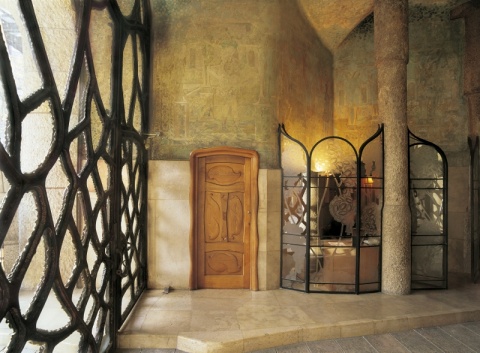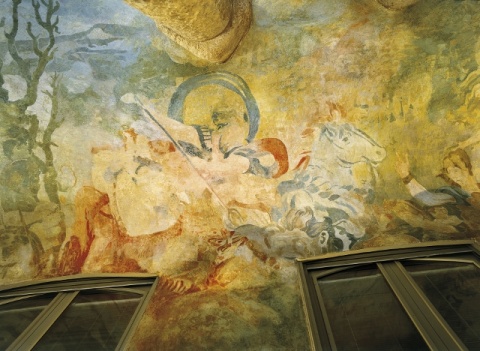The mural paintings of La Pedrera
The god Pan playing the panpipe, a garden, the Deadly Sins, bouquets of flowers, the god Vertumnus disguised in an attempt to seduce the goddess Pomona, a feast, a sun, an eagle, and even a shipwreck – these are just some of the scenes featured in the mural paintings in the vestibules of La Pedrera.
When the wrought iron door of the building opens before us, we are awed by the paintings on the walls and the ceilings of the vestibules. Visitors, who photograph every detail of the murals, seem less amazed by their iconographic meaning, which is difficult to discern at first sight, as by the exuberant use of colour.
Little has been written about these murals. Some authors have even remarked that the paintings are out of keeping with the modernity that La Pedrera represents. Nevertheless, the pictorial decoration of the vestibules is an essential part of the building’s decoration, as was the sadly lost decorative artwork of the dwellings. The painting decoration of the vestibules consisted of mimicking tapestries of mythological motifs held in the National Heritage collection.
The latest research by Dr Carlos Alejandro Lupercio has accredited the authorship of the mural paintings, and has identified the scenes depicted in the vestibules. The Symbolist painter Aleix Clapés (1850 – 1920) was entrusted, between 1909 and 1911, to oversee the pictorial decoration of La Pedrera. Clapés was aided by his assistants, the well-known painters Iu Pascual, Xavier Nogués and Teresa Lostau, who were just starting out.
The video takes us through the two vestibules of La Pedrera, showing the pictorial repertoires and documentary references.
Contributor:
- Fundació Catalunya-La Pedrera


